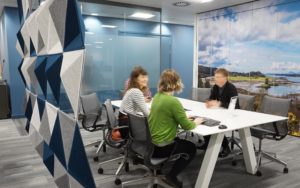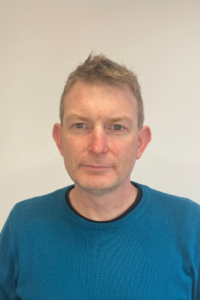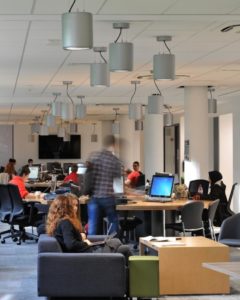“Yes we can” was an enduring soundbite from Barack Obama’s presidential campaign in 2008. It wasn’t a new message, however. Rosie the Riveter said, “We can do it!” during World War II and in fact, it was Cesar Chavez who originally came up with the “Yes we can” slogan in the early 1970s.
A good idea or a good message is timeless and can be used again and again, often in totally different contexts from the original meaning. In the realm of workplace design and managing change in the workplace “Yes we can” has been the resounding response to the question “Can we do things differently?” during the past two years. Organisations of all sizes, across the public, private and charitable sectors, have taken the change in office working to heart.
No one size fits all
Doing things differently is completely unique to each organisation. How each one responds to the need for change comes after honest discussions about the future vision. Encouraging participation in these discussions is often a balance between embracing change while maintaining some of the status quo. As each organisation is different, one size does not fit all.
Take a contact centre as an example: the words conjure up a vision of rows and rows of desks with handlers chatting away on headsets and supervisors walking the floor, problem-solving left, right and centre. In some instances, this is still the case; it’s all about physical presence, monitors on walls displaying call-waiting times, and face-to-face supervision. However, one outcome of the pandemic has been that call-handling can now be managed remotely, with reduced physical attendance at work. For many of these organisations, the rows of desks are no longer necessary for service delivery. As a result, in some of these, where desks are being removed (or in extreme cases, contact centres are being rationalised), there is now the need for a decision on how best to use the left-over space and manage the hybrid workforce.
So, what does “doing things differently” look like for two of our clients, one from the public sector and one private?
Using space differently
SPACE was recently involved in the creation of collaboration zones within existing floorplates for a Utilities client. The main purpose of change was to further encourage collaboration within the teams, with the added challenge that we were recycling furniture from other UK sites rather than starting afresh. The client was keen that the new space did not look like an afterthought but was mindful of colours and styles to create an overall aesthetic.
After discussions with each site on how to utilise their spaces and on how the offices worked, it became clear that getting together for a quick “show and tell” was far more important than the more formal spaces many of us have become used to. The tech-free space required by a call centre to allow staff to relax is now less useful than a space where they can meet up because they no longer see each other every day. Of course, there was still the need for formal rooms at each site to fulfil the more technology-based training sessions, but what became clear was that when staff were in the workplace for their planned catch-up, they wanted to be together as much as possible – this even led to alterations to the staff kitchen spaces.
Initially, our brief was for a straight ‘remove X desks and add new furniture in’ project. To respace and replan floorplates was not the original intention, but zoning and acoustics, which are already critical in contact centres, became even more important and required a different approach at each site. Some wanted large, multi-setting collaboration zones where three or four teams could gather separately and would plan to meet within the space for collaboration. In other sites there was a desire to have more local collaboration settings that would support both large, planned get-togethers, but also encourage spontaneous small group interactions between team leaders.
Adding different spaces
Regulation and the amount of available technology meant that the flexibility experienced by the example above, was not suitable for another client of ours. Where they also operate contact centres, these are based in the public health sector. In this environment, having people in the same physical space is operationally critical and floorplate efficiency is still the most important issue. Intelligent space planning on the main work floors was essential when having to combine physical distancing with our designers’ need to create a more spacious environment. While compromise can sound negative, in this case it was about achieving the balance between numbers and social distancing in a positive way, while also being mindful of workplace acoustics.
In the current climate, working in the public health sector has had more challenges than usual. For this reason, we paid more attention in our design to the non-work areas that support call-handlers when they are on their breaks. This longstanding client was one of the first to specifically ask for decompression spaces where staff could recover after what can often be a life-or-death phone call.
Breakout space remains an important part of the office layout. In our experience generally, the kitchen has become a more important social hub than before, and relaxation areas are larger than ever. However, where decompression is so vital, as in public health call centres, some people want more private space where someone can be alone, or where two people can support each other. The definition of collaboration is not the same as the other client example, as it’s less about forward planning and more about listening in a safe, often domestic-style, technology-free environment. It’s as vital for team morale to know that they have somewhere private as it is to have communal dining tables where the team can gather over lunch.
Support your team
Each organisation is unique and where handling utilities calls has its own challenges, it is less likely to be a life-or-death situation. Where both organisations work in the same way in terms of call-taking, each one has its own breakout needs. For one of them, fostering team spirit requires spaces that are both social and collaborative; whereas for the other, peer support and privacy are more important to allow the team to function properly.
Two clients: one public and one private, both delivering a similar customer-facing service, but with totally different requirements for changes to their workplace – and with two very different outcomes.




